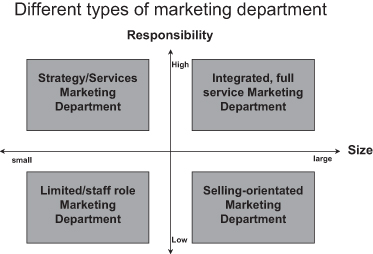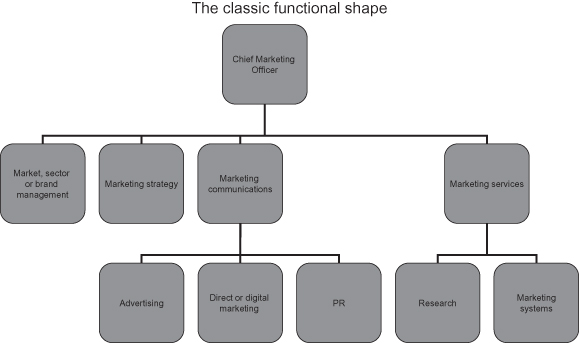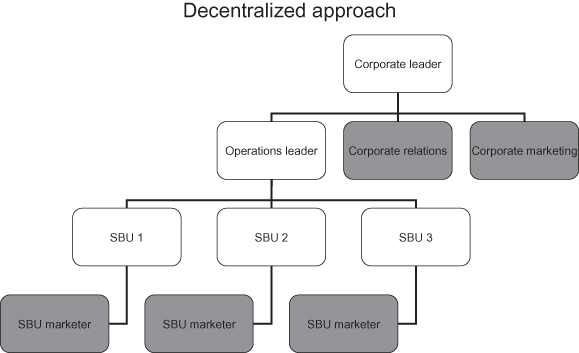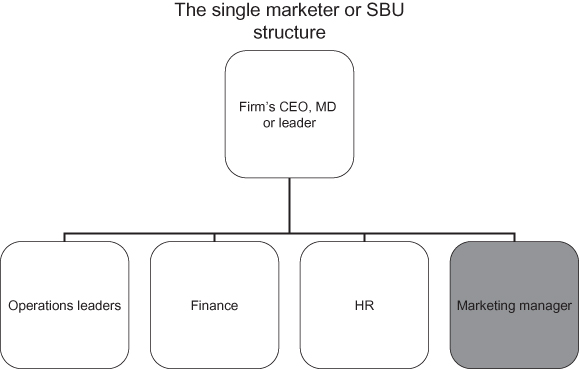![]() ORGANIZATIONAL COMPETENCE IN MARKETING
ORGANIZATIONAL COMPETENCE IN MARKETING
Application: Marketing Effectiveness, Strategy
Figure O.3: A representation of the evolution of different marketing departments

The Concept
Much of the published work on marketing focuses on theory, concepts, or practice and makes assumptions about the way the function works in a firm. Most assume that there is a well developed organization led by a marketing director or CMO, able to call on financial and human resources to undertake research, manage advertising, or adjust product features in the light of rational, justified arguments. There is little talk of the need to convince organizations of marketing’s importance, of competing for resources, or of organizational politics.
The situation is rarely so clear-cut. The marketing function is often under-developed. It has to argue for its role in the organization and has to invest in processes, as well as running projects to generate revenue. Some companies do not understand their own need for certain marketing skills and restrict the contribution that the function makes, limiting it to, say, a minor promotional role. In many firms, marketers spend their time running around making PowerPoint presentations to each other or organizing the mind numbing detail of different events. This is not effective marketing and does not necessarily create wealth.
Responsibility for the organizational competence of the function normally rests with the “chief marketing officer” (CMO). As leader of the function this person has several roles. The first is to provide marketing experience, judgement, and advice to the firm’s leaders about policies; to round out and inform decision making and strategy development. The second is to be the voice of the market within the firm, challenging it to embrace opportunities and understand customer needs. The third is to lead the function, ensuring that it is properly resourced and contributes appropriately. There is almost complete unanimity amongst marketing specialists that one of the main roles of the CMO or marketing leader is to maintain a perspective on the market and articulate that to the company; acting as the voice of the market into the organization.
It is less frequently argued (but more frequently experienced by those who do the job) that the CMO has a responsibility to ensure that the firm has the organizational competence to meet the demands of the market. This has two elements. The first is highlighting to the leadership of the firm those areas where it needs new skills or processes, in any part of the firm, to tackle competitive threat or market opportunity. The second is developing the competence of the marketing function itself to tackle strategic imperatives.
The first is likely to arise from the firm’s strategic planning process. The leaders need a clear perspective on three things: market trends, competitive moves, and the firm’s competences. These are likely to reveal changes which need to be made in order for the firm to thrive. It is the role of the marketing leader to identify these issues and illustrate how their absence threatens the firm. While the development of the organizational capability to meet the problem might not rest with the marketing function, the facilitation of a strategic debate does. Similarly, the function has a responsibility to review the result of the project and to ensure that it has met its intended objective so that it can compete effectively. A tool which helps with this is a market audit, a systematic review of the marketing and sales capability of the firm against its competitive backdrop (see separate entry under market audit).
Unfortunately, by no means every business has a CMO or even an experienced marketer. Small firms or new start-ups can have very modest marketing resources. Yet, there is evidence that marketing capability increases as companies grow and work through different inflection points in their development. As small firms grow, marketing specialists are recruited into different places in the organization, such as public relations and sales support. Later, this develops into the fully integrated marketing function seen in many corporate firms. A large corporate entity might have several hundred marketing specialists running campaigns, integrated by both a hierarchical senior management team (culminating in a CMO) and by the use of common processes and technology. The development of marketing in many leading companies has been through this evolution as their market situation has changed. So, it is the role of senior people in the function (particularly marketing directors or CMOs) to think about how the marketing function should evolve and, in fact, how the marketing competence of the whole firm should be facilitated.
In publicly owned companies, marketing is likely to be the responsibility of a relatively small specialist unit comprising people who are qualified and experienced. They will be responsible to the management team for creating strategy, plans, budgets, and programmes to grow the business. They will also be expected to balance the skills, resources, and processes of the marketing department to optimum effect and for the benefit of the business in its market. They will have delegated responsibility to manage the function effectively, and will need to ensure that it has good knowledge of relevant concepts, develops appropriate competencies, uses reliable techniques, and installs robust processes or systems. On top of this, they will need to engage with the whole firm to ensure that the customers’ experiences are appropriate to meet the firm’s objectives. In short, the marketing function needs to keep up-to-date and act as a catalyst for the business in its approach to market.
Figure O.4 tries to show the typical functions within a unit of this kind but these can vary enormously. For instance, brand management might exist within market management (because it focuses on market categories or in marketing communications. Sales and sales support might be combined with marketing under one “sales and marketing” director or vice president. Also, there may be elements of the marketing mix in other parts of the organization. For example, some firms place new product development and pricing under a separate director. Others have directors dedicated to corporate relations, responsible for reputation, brand, corporate social responsibility (CSR), and public relations.
Figure O.4: A representation of the classic shape of a marketing department

Not all marketing is undertaken in the carefully organized departments of large publicly owned companies. In small firms and professional partnerships, the situation tends to be more fluid and less clearly defined. Different people will initiate marketing activities, which are frequently handled by executives who have no specialist marketing knowledge and may not be aware of other marketing initiatives in different parts of even their own company. If a marketing manager or marketing department exists, which is by no means certain, they may not have exclusive responsibility for all revenue generation tasks. The business world is not uniform. Companies succeed with a huge diversity of products and services, with very different cultures and operating approaches in a wide range of markets. Marketing has to be adjusted to suit these very different environments if it is to be successful.
One of the main business types is, for example, the conglomerate or decentralized business. Figure O.5 represents this type of decentralized organization with devolved business units, (like IBM, Ericsson, or Phillips). These “strategic business units” might be businesses specializing in different disciplines or in different geographies. The effectiveness and behaviour of the marketers depend on the degree of autonomy of the different units. Marketers in these, SBUs, will be expected to work within tight corporate guidelines. They are likely to have a clear job description with defined competences and objectives. They are also likely to report regularly to the corporate function and participate in clear, firm-wide processes. At the other extreme, though, are large conglomerates that own separate firms with different profit pools (like Ingersoll Rand, Virgin, or ABB). The marketers in these firms are likely to have greater autonomy within very broad corporate guidelines.
Figure O.5: Marketing in a decentralized organization

On the other hand, the majority of businesses range from tiny start-ups to medium-sized companies. In these, any specialist marketing units are limited by resource constraints; often to a single, or isolated, marketer, depicted in Figure O.6. One person is all that the business can afford, and that person is likely to report to the firm’s leader, gaining authority to create programmes, strategy, and change from the closeness of that relationship. Constrained by lack of resources, the single marketer needs influence to get the wider organization to take on work and the budget to rely on external contractors. They need the capability to handle a wide variety of tasks and the humility to do much of the work themselves. In some firms, they report to a functional leader who manages all specialists (HR, finance, IT etc). This, however, tends to be less effective because it weakens the assumed authority behind the speciality, reducing the influence of marketing.
Figure O.6: The single marketer

One difficulty in this environment is the marketing skills that small firms can afford. They frequently hire young professionals or marketers from middle management in other firms who have never really progressed in their career. They might lack gravitas and be unable to convince their leaders to invest in needed initiatives or to adopt new policies. Consequently, they tend to focus on promotional work, and are frequently unaware of sophisticated marketing techniques that might be more profitable and effective for their firm. They are often weak at giving credible strategic insight to influence the direction of the firm.
A wide range of companies, both large and small, have yet another form of governance: the intuitive business leader. These creative entrepreneurs tend to use the principles of marketing, based on their business experience and intuition. Individuals (from Richard Branson, Simon Cowell, Alan Sugar, and Phillip Green in Britain to Donald Trump, Bill Gates, Larry Ellison, Michael Dell, and Steve Jobs in the USA) become millionaires, or even billionaires, through an intuitive approach to markets. They are pre-eminent practitioners of marketing, creating enormous wealth for themselves, their investors, their employees, and society as a whole.
They frequently succeed by breaking rules (Harvard would not have advised young pop entrepreneur Branson to go into the airline business, for instance) and shake up or create markets. Their emphasis is on customers and markets, so they push all the elements of their business to focus on external opportunities rather than internal activities. They also tolerate both risk and failure. As their businesses grow, the most successful learn to use specialists (like accountants, lawyers, and merchant bankers) to round out or refine their vision and instinct; and most use marketing specialists (either as employees or through agencies) in a similar way.
The cultures of their highly successful, market-orientated, businesses are focused on understanding and executing the leader’s will. Much time is taken to tease out, develop, and communicate their vision and implement it throughout the organization. Their marketing is therefore most often about connecting the leader’s vision with a market opportunity. In some cases, the marketing structure is a small, fluid team, in another a trusted agency and, in yet another, the more recognizable structures of big, publicly owned firms. They use novel marketing techniques, frequently exploiting publicity opportunities and, in some cases, breaking away from the rules of consumer product marketing to pioneer other techniques.
Finally, much marketing occurs in the marketing supply industry, working on behalf of their clients. This is a very diverse range of businesses. It includes advertising, direct marketing, and new product development agencies, as well as a variety of consultancies. They range from the huge conglomerates like WPP to single person businesses. Despite the fact that most of the writing and theory of marketing is developed from and for marketing specialists in large companies, much of the real added value comes from agencies. It is the role of leading marketers inside client companies to establish processes and strategies whereby their firm gets the best from these agencies at the optimal cost, making them part of their company’s organizational competence in marketing.
History, Context, Criticism, and Development
The ability of the marketing function to contribute effectively to income generation and the health of the business depends on the role it has in the organization and its maturity. In many long-standing consumer goods businesses (Proctor & Gamble, Unilever) or confectioners (Mars), it is a lead function of the business. The firm recruits the cream of the graduate crop into a professional apprenticeship scheme that provides some of the best marketing training in the world. Alumni of the programme progress through the firm from junior brand managers to marketing directors. Their role is to generate income from branded value propositions, using wide-ranging and proven marketing techniques. Over many decades, these companies have institutionalized marketing into a leading philosophy of the entire corporation.
In other industries, however, the contribution of specialist marketing people is limited to minor functional roles like sales support, PR, or brochure creation. The formal marketing function is not as valued because the income of the business is generated by other means, such as a strong and healthy natural demand for an innovative product or systematic account management. But, there is evidence that this changes as markets mature. For instance, most of the consumer goods companies evolved first rate and leading marketing units because they experienced market maturity in the developed economies during the 1950s and 1960s. Similarly, marketing has become more important to the car industry, the computer industry, and the telecommunications industry, as they, in turn, have faced market maturity. As IBM has adapted to its changing market conditions, for instance, the marketing function within the company has developed its own competence to keep pace. As the case study in the brand section shows, starting from a strong heritage in sales, it has progressively become one of the most sophisticated in the IT sector, combining knowledge of marketing concepts with impressive marketing people and real customer insights through growing organizational competence.
Professor Nigel Piercy’s research (Piercy, N., 2001) showed that there was rarely consistency about what activities marketing leaders have responsibility for. Nor was there consistency in the shape of organizations. Yet, he found four development phases in the evolution of the competence and significance of marketing departments. They were:
- Integrated/full service: closest to the theoretical models and with a wide range of responsibilities and power in the organization;
- Strategic/services: smaller units with less power and integration. Their influence is in the area of marketing support services or specific policies/strategies;
- Selling overhead: often large numbers and dispersed but primarily engaged in sales support activities;
- Limited staff role: small numbers with few responsibilities and engaged in specific staff support such as market research or media relations.
He suggested that marketing departments evolve (from a limited staff role to fully integrated) as firms grow and marketing grows in importance within them. When a company is initially formed, much of the marketing role is undertaken by the founders or specialist subcontractors (like PR agencies). Some time after that a marketing specialist will be hired to manage specific activities such as brochure production, new product launch, and perhaps some advertising. Marketing’s leading thinker and educator, Phillip Kotler, has also noticed, through his many years of engaging with different businesses, this evolution of marketing competence (Kotler, P., 2006).
Voices and Further Reading
- “… the nature of the marketing function varies significantly from company to company. Most small businesses (and most businesses are small) don’t establish a formal marketing group at all. Their marketing ideas come from managers, the sales force, or an advertising agency. Eventually, successful small businesses add marketing person (or persons) to help relieve the sales force of some chores … Both sales and marketing see the marketing group as an adjunct to the sales force at this stage.
As companies become larger and more successful, executives recognize that there is more to marketing than setting the four P’s … They determine that effective marketing calls for people skilled in segmentation, targeting and positioning. Once companies hire marketers with those skills, marketing becomes an independent player …
Once the marketing group tackles higher-level tasks like segmentation, it starts to work more closely with other departments, particularly strategic planning, product development, finance and manufacturing. The company starts to think in terms of developing brands rather than products, brand managers become powerful players in the organization. The marketing group is no longer a humble ancillary to the sales department.” Kotler, P., 2006.
Things You Might Like to Consider
(i) Marketing managers need to be interested not only in the organizational capability of the marketing function, but also the productivity and effectiveness of sales channels and the general go-to-market capability of the whole organization. These are as much part of strategy development as issues like positioning or segmentation.
(ii) It is part of marketing management to review and develop the performance and capability of the marketing organization in the light of the changing needs of the company.
(iii) Really well developed marketing capability and a track record of success do not, it seems, avoid massive marketing mistakes. Coca-Cola is, without question, one of the marketing successes of the 20th century. Successive generations of marketers and marketing-orientated leaders have created enormous wealth from their little black drink. They have used the full extent of all marketing techniques for many decades. This heritage did not stop them, though, from messing up on a grand scale when they tried to drop the original drink for “New Coke” at the end of the 20th century and, later, when they tried to launch bottled water in Britain.
![]() RATING: Practical and powerful
RATING: Practical and powerful
